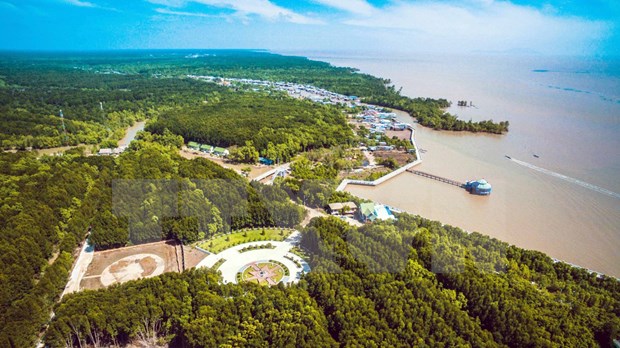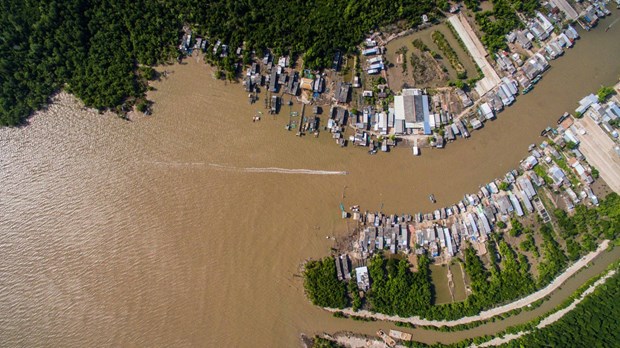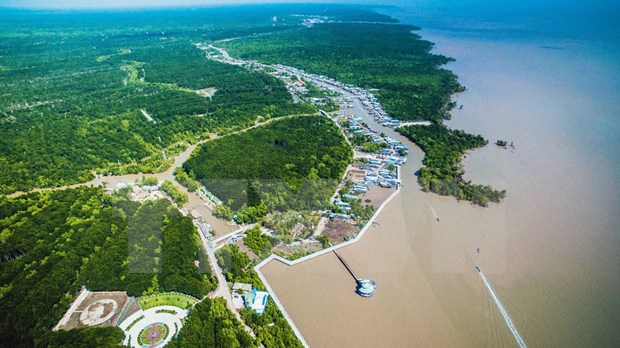Developing biodiversity of Ca Mau Cape Biosphere Reserve
 An ariel view of Ca Mau Cape National Park (Photo: VNA)
An ariel view of Ca Mau Cape National Park (Photo: VNA)Hanoi (VNA) - Ca Mau Cape Biosphere Reserve is one of the famous destinations with typical geographical, cultural and ecological characteristics of the whole country, with unique features of special estuary and coastal eco-regions. Ca Mau Cape is also a sacred place in the hearts of every Vietnamese, everyone wants to once set foot on the southernmost point on the mainland of the country. In that sacred land, you will once touch on a proud landmark of sovereignty, or stand on an iconic ship heading straight to the East Sea.
Typical ecosystems
Ca Mau Cape World Biosphere Reserve consists of Ca Mau Cape National Park (in Ngoc Hien district) and U Minh Ha National Park (U Minh district) in Ca Mau province. The reserve covers over 371,000 ha with three zones: the core zone with 17,329ha, the buffer zone with 43,309 ha and transient area with 310,868 ha.
Researches from the Ca Mau Department of Science and Technology showed that reserves in Ca Mau Cape are diverse, reflected in unique biosphere, rarely seen in the world.
 A corner of Ngoc Hien district (Photo: VNA)
A corner of Ngoc Hien district (Photo: VNA)With characteristic ecosystems like mangrove forest ecosystem, flooded peat ecosystem and maritime ecosystem, the biosphere reserve is the common home for thousands of creatures and the shelter of geological resources. According to the survey of the Ca Mau Mangrove Forest Research Centre, in 2006, the ecosystem had 22 species of salt-marsh trees, 13 animal species, with two listed in the World Red Book, namely Macaca fascicularis and Trachypithecus cristatus and four in the Vietnam Red Book, 74 bird species in 23 families and 28 migrant bird species, including many listed in red books.
The Ca Mau Cape National Park was established in 2002.
Encompassing Dat Mui, Vien An and Dat Moi communes in Ngoc Hien district, Ca Mau province, the park covers over 41,800ha, including 26,600ha of coastal areas and 15,200ha inland.
It is home to 93 species of birds, 26 species of mammals, 43 species of reptiles, nine species of amphibians, 139 fish species and 53 mollusc species. Of these, many are listed in Viet Nam's Red Book and the Red Book issued by the International Union for the Conservation of Nature that heralds the plight of endangered species.
In 2009, the United Nations Educational, Scientific and Cultural Organisation recognised Ca Mau Cape National Park as a World Biosphere Reserve.
In April 2013, the park became the 2,088th Ramsar site in the world (wetlands of international importance designated under the Ramsar convention) and the fifth Ramsar site in Viet Nam. The others include the Xuan Thuy Natural Wetland Reserve in the Red River Delta province of Nam Dinh, Ba Be Lake in the northern mountainous province of Bac Kan, Bau Sau in Cat Tien National Park in the southern province of Dong Nai and Tram Chim National Park in the southern province of Dong Thap.
Sustainable conservation and development
The fact that Ca Mau Cape was recognized as a World Biosphere Reserve has made an important contribution to the conservation of biodiversity of the wetland ecosystem and the preservation of human values for the purpose of sustainable development.
Ca Mau's provincial authorities are making every effort to conserve the Ramsar site by experimenting with conservation models that use the mangrove swamp's resources in a sustainable fashion, promoting the economic value of wetland ecosystems.
 An ariel view of Ca Mau Cape National Park (Photo: VNA)
An ariel view of Ca Mau Cape National Park (Photo: VNA)In order to improve the efficiency of management, conservation and sustainable development of the Ca Mau Cape World Biosphere Reserve, the People's Committee of Ca Mau province requested relevant agencies and units to coordinate in implementing Decision No. 36 of the Provincial People's Committee on promulgating a regulation on the management of the Ca Mau Cape World Biosphere Reserve, effective from the beginning of 2021.
Chief of Office of Provincial People's Committee, Director of the Department of Agriculture and Rural Development, Director of the U Minh Ha National Park, Director of Ca Mau Cape National Park, Chairman of the People's Committees of U Minh and Tran Van Thoi, Phu Tan, Nam Can, Ngoc Hien districts and related agencies and units shall coordinate to well implement the regulations on the management of the Cape Ca Mau World Biosphere Reserve.
The park's management board has been working with the local authorities and agencies as well as domestic and foreign organisations to hold regular education campaigns to raise the public's awareness of the laws and regulations on forest and sea management and protection. This will increase the local community's involvement in helping to conserve the park's biodiversity.
At present, 12 monitoring groups have been set up to patrol and protect the park.
Several community-based programmes are also underway to safeguard the park, while the park itself has come up with several ways of getting the local people to contribute to the ecotourism operation in whatever way they can.













